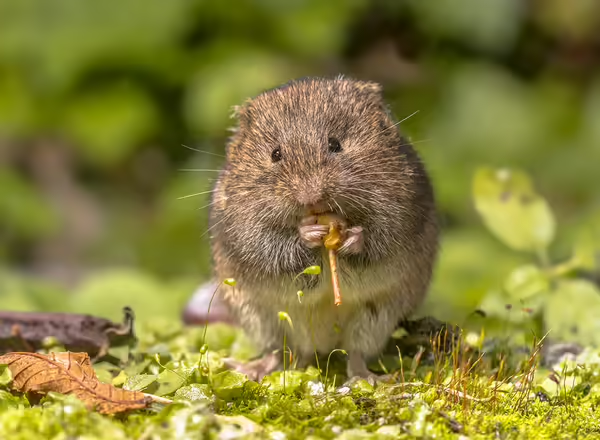
Vole
Voles, microtus spp., can damage numerous plants and plant parts under four or more inches of snow.
Life Cycle
Voles reproduce several times per year, producing several offspring per litter. That, combined with young reaching adulthood in just a few weeks, allows large numbers of voles to be produced. Voles can live 2-3 years, but usually are killed by predators within a few weeks to months.

Voles can cause serious damage and even death of woody plants. Voles have short tails while house mice and other mice have a relatively long tail. The coloring is similar, although a vole is about half again bigger than house mouse. Vole damage usually occurs during the winter. It often occurs in landscapes where there is a "natural or wild" area that touches the property line. Vole damage also occurs in landscapes that have naturalized areas, deep mulches,or large groupings of ornamental grasses or groundcovers. These give the voles a suitable habitat that allows them to breed and reduces predation on the voles. Voles eat the bark and cambium off of many plants during the winter when more suitable food supplies are limited. If the vole girdles the branch or trunk the plant above that location dies. Snow of three or more inches on the ground allows the vole to tunnel under the snow from the normal habitat to the junipers, arborvitae, fruit trees or other plants to feed on the bark and cambium.
Voles will also feed on turf, particularly near protected areas as listed above. They feed on the roots, stems, and shoots of the grass, leaving meandering trails and runways about two inches wide. Occasionally, burrows 2-3 inches in diameter will be dug deeper into the soil.
Management
Either use hardware cloth of 1/4 inch mesh or smaller around the desirable plants or remove the snow from around the base of the plants. Allow at least one foot or more shoveled area all the way around the base of the tree's trunk.
Mulch should be only 2-3 inches deep to reduce their burrowing. Thin out spreading junipers and other groundcovers to reduce vole cover. Remove dead stems from ornamental grasses and perennials to reduce winter cover.
Damaged turf will repair itself rapidly in the spring. Overseeding will aid this recovery.